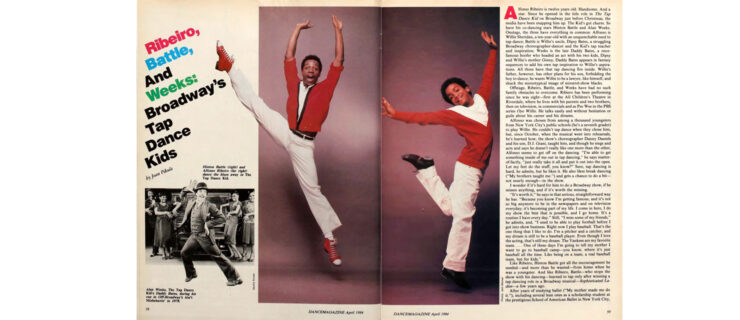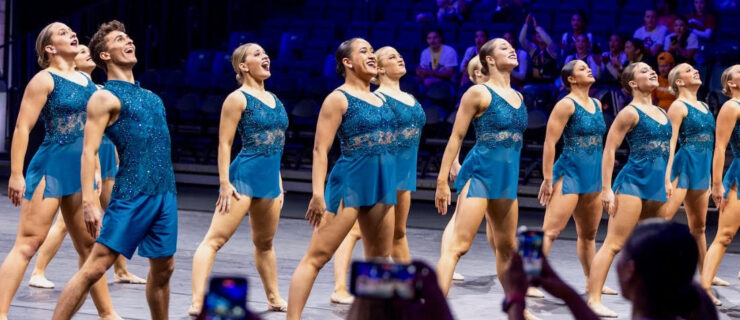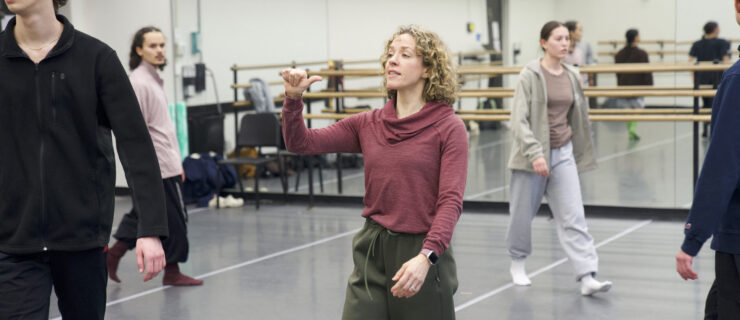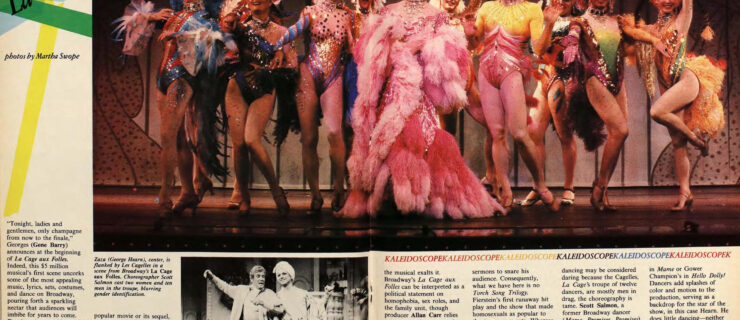Rhythm Mash-ups
Kathak master Pandit Chitresh Das improvises with tap dance whiz Jason Samuels Smith. Champion Irish dancer James Devine studies rhythm tap and creates his own style of Celtic tap. Renowned tap dancer Roxane Butterfly receives an e-mail request from Swaziland to collaborate with gumboot dancers. While these scenarios are not new to the world of percussive dance, they are happening with greater frequency thanks to the power of the Internet, the limitless portals of online video, and the ease of modern-day travel. Percussive dance forms that were once worlds apart are now closer—often sharing the same stage. Call it collaboration. Call it exchange. Call it noisy. Just don’t call it fusion!
“There is a lot of confusion regarding fusion,” Butterfly says with a laugh. “There are very few true fusions. Fusion takes time spent living in the other culture. You need to learn their codes, otherwise you just pretend to fuse. I’m far too respectful of people coming from another tradition to pretend that I’m fusing with them.”
Butterfly, a 15-year veteran of working with percussive forms outside of tap dance, describes the process as “an encountering” and believes that a dance form’s relationship with its music is the key to mutual understanding between different styles. “For me, the path to other percussive forms lies in learning how their dance works within a musical context,” she explains. “I don’t want to learn their steps—I already have lots of steps. I want to understand how they use their steps within their musical idiom, because that is how we will communicate.”
In 2005, Butterfly and flamenco artist Susana di Palma were invited by Minneapolis-based kathak dancer Rita Mustaphi to collaborate on a work entitled Naari—The Woman. “We worked with each other’s music, which was challenging,” di Palma says. “Tap is generally in 8s. Kathak has a range of different rhythmic patterns. Flamenco uses 12s or 6/8 or 3/4 mixtures. But we found that 4s go into just about everything. You think that things are complex, but then you find that common pulse—that 2/4—which is breath and heartbeat.” Di Palma appreciates the sense of camaraderie that collaboration brings. “If you are a percussive dancer, you often feel that you are in a less popular, less funded corner of the dance world,” she says. “Yet I see our audiences excited in a way that I don’t see at other kinds of dance concerts. It comes from the rhythm. It gets in people’s blood.”
Collaboration can also be useful in building a crossover audience for dance. Since 2005, Pandit Chitresh Das and Jason Samuels Smith have been performing India Jazz Suites, a dialogue between kathak and tap. “Our audiences are extremely diverse, from conservative Indian families to young American kids from the hip hop generation. We attract them all. Whether we perform in India at a prestigious music institute or in New Orleans for a group of school kids, the response has been tremendous,” Samuels Smith says. “The show represents the idea that beyond race, age, class, culture, political or religious beliefs, we can share the same passion with two completely different styles.”
Both forms in India Jazz Suites use rhythm as the driving force, but the production of sound is very different. Metal plates are used in tap shoes, while ghungroos (bells wrapped around the leg above the ankle) are used by barefoot kathak dancers. The difference highlights the power of dance as a means of communication across cultures. “We have performances before very conservative Indian audiences where shoes are not allowed on the stage,” says Das. “I say to them, ‘Bells are sacred to me and tap shoes are sacred to Jason.’ And the Indian audiences accept it.”
Footgear aside, tap and kathak have many similarities. “Improvisation, or upaj, is very important in both forms,” says Samuels Smith. “The idea of trading steps with a sense of one-upmanship is also common. Our entire show is improvised except for the tihais [a rhythmic cycle repeated three times at the end of a piece], which are set so we can finish together.” India Jazz Suites incorporates both jazz musicians (a drummer, bassist, and pianist) and classical Indian musicians (a tabla player, sitarist, and sarangi artist). The dancers perform with their own style’s musicians first and then dance with each other’s musicians. “Improvisation involves risk-taking. You can’t be worried about everything being clean,” Das says. “I’m not saying you should be sloppy. I’m saying you need to come out of the box!”
Learning to improvise was a critical step for Irish dancer James Devine in the creation of Celtic Tap, his signature blend of Irish step and rhythm tap—and the title of his latest production. Named “the fastest dancer in the world” by Guinness World Records, Devine discusses the difference between Irish dance and tap: “Irish dance is primarily a learned art form, whereas tap dance is based on improvisation. Tap dancers are finely tuned to what the musicians are playing. They interpret the music like a percussionist would. When Irish dancers ‘step about’ to a tune, they dance a complicated series of steps, but usually it will be from memory.”
In 1997, while on tour with Lord of the Dance at Radio City Music Hall, Devine caught a performance of Bring in ’Da Noise, Bring in ’Da Funk. “Under its spell,” he recalls, “I briefly signed up for rhythm tap lessons. Until then, I had only been exposed to Irish dance, but those initial lessons began what I consider a never-ending journey for me to explore other percussive art forms. One thing that I changed in the Irish style was to come off the balls of my feet and dig the heels into the ground. That enabled me to incorporate tap into my style.” Devine’s performances of Celtic tap are largely improvised and embrace a number of musical genres, including Celtic, jazz, classical, funk, and country. “Improvisation is the ultimate in freedom of expression,” he declares. “There is a strong edge to it that is in the moment. It’s raw.”
Improvisation is also a key tool for eclectic dance artist Sandy Silva, who performs with the Quebecois band La Bottine Souriante, among other projects. “When you have a vast language that is practiced, you can draw on it in the moment. Improv is knowing what you are doing and letting it go!” she says. “I know the tunes so well that I’ll know when a certain accent is coming up. But there are a hundred ways that I could hit that accent. Or, maybe I want to converse with that accent.” She combines body percussion with the rhythms of Irish step dance, Spanish flamenco, American tap, Hungarian legényes, and Appalachian buck dance. “When you work rhythmically, you can go anywhere, because you don’t have the stylistic thing. It becomes a visual representation of the music,” Silva explains. “The core is embodying the music both sonically and emotionally. How does your body react to the sounds that you are making? When you hit your chest, you feel that reverberation in the chest cavity.”
Silva is currently developing an ensemble in Montreal with performers who have diverse backgrounds in percussion, music, dance, and theater. About their rehearsal process, she says, “We take sheet music from ‘Syncopation for the Modern Drummer’ and put it on the body. We make the bottom line the hands and the top line the body. Now, here’s the vocabulary. Let’s go!”
Developing a shared vocabulary has been just as essential to Max Pollak and his ensemble RumbaTap, a mixture of Afro-Cuban music and dance rhythms with American jazz, tap dance, and body percussion (see “Global Tap,” May 2007). “I treat the technique like drumming and I teach it like music. I don’t let anyone put on their tap shoes until they’ve mastered the rhythms of the body percussion,” Pollak explains. “When we put it together with the band, it becomes another weight of responsibility because the dancers are absolutely the percussionists. The sax, marimba, and vocalist are listening to us. RumbaTap is first and foremost a music ensemble. We just happen to be moving.”
Pollak credits both ease of travel and the Internet for increasing the opportunities to engage with other percussive forms. “I’ve definitely seen more and more cross-pollinations in the last five years. People travel more. People go to each other’s websites,” Pollak says. “Being a New York City resident also helps. We live the Internet. We are globalization. We see interactions in our city all of the time. You can’t help it. It’s a burning desire of the human condition to express in rhythm and motion at the same time.”
Darrah Carr is a NYC-based writer, choreographer, and educator active in both the Irish and modern dance communities.
Photo of Rita Mustaphi by Eric Saulitis, courtesy Mustaphi




